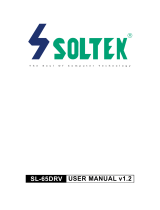SOYO 6KBE User's Manual & Technical Reference
- Type
- User's Manual & Technical Reference
This manual is also suitable for
The SOYO 6KBE mainboard supports high-speed computing with Pentium II CPUs up to 333 MHz, 512MB of ECC or Parity memory, and a 66 MHz host bus frequency. It features an AGP slot for accelerated graphics, four PCI slots for expansion cards, and three ISA slots for legacy devices. The board also integrates dual high-speed UARTS, a multimode parallel port, a PS/2 mouse port, and onboard SCSI and IDE controllers for flexible peripheral connectivity. With its robust feature set, the SOYO 6KBE is ideal for building powerful and versatile desktop computers.
The SOYO 6KBE mainboard supports high-speed computing with Pentium II CPUs up to 333 MHz, 512MB of ECC or Parity memory, and a 66 MHz host bus frequency. It features an AGP slot for accelerated graphics, four PCI slots for expansion cards, and three ISA slots for legacy devices. The board also integrates dual high-speed UARTS, a multimode parallel port, a PS/2 mouse port, and onboard SCSI and IDE controllers for flexible peripheral connectivity. With its robust feature set, the SOYO 6KBE is ideal for building powerful and versatile desktop computers.




















-
 1
1
-
 2
2
-
 3
3
-
 4
4
-
 5
5
-
 6
6
-
 7
7
-
 8
8
-
 9
9
-
 10
10
-
 11
11
-
 12
12
-
 13
13
-
 14
14
-
 15
15
-
 16
16
-
 17
17
-
 18
18
-
 19
19
-
 20
20
-
 21
21
-
 22
22
-
 23
23
-
 24
24
-
 25
25
-
 26
26
-
 27
27
-
 28
28
-
 29
29
-
 30
30
-
 31
31
-
 32
32
-
 33
33
-
 34
34
-
 35
35
-
 36
36
-
 37
37
-
 38
38
-
 39
39
-
 40
40
-
 41
41
-
 42
42
-
 43
43
-
 44
44
SOYO 6KBE User's Manual & Technical Reference
- Type
- User's Manual & Technical Reference
- This manual is also suitable for
The SOYO 6KBE mainboard supports high-speed computing with Pentium II CPUs up to 333 MHz, 512MB of ECC or Parity memory, and a 66 MHz host bus frequency. It features an AGP slot for accelerated graphics, four PCI slots for expansion cards, and three ISA slots for legacy devices. The board also integrates dual high-speed UARTS, a multimode parallel port, a PS/2 mouse port, and onboard SCSI and IDE controllers for flexible peripheral connectivity. With its robust feature set, the SOYO 6KBE is ideal for building powerful and versatile desktop computers.
Ask a question and I''ll find the answer in the document
Finding information in a document is now easier with AI
Related papers
-
SOYO 6KB82440 User manual
-
SOYO 6BE+ User manual
-
SOYO 82430 TX User's Manual & Technical Reference
-
SOYO 82430 TX P54C User's Manual & Technical Reference
-
SOYO 82430 TX Users Manual And Technical Reference
-
SOYO 5eh5 User manual
-
SOYO 5ED5 User manual
-
SOYO 6KME User's Manual & Technical Reference
-
SOYO 6KF User's Manual & Technical Reference
-
SOYO 82430 TX User's Manual & Technical Reference
Other documents
-
Gigabyte GA-6VA7 User manual
-
Gigabyte GA-6SMM7 User manual
-
Gigabyte GA-6SMM7 User manual
-
VIA Technologies Zida BX983D User manual
-
Gigabyte GA-5SG100(GA-5SG) Owner's manual
-
 AZZA 810T Series User manual
AZZA 810T Series User manual
-
 SOLTEK SL-65DRV User manual
SOLTEK SL-65DRV User manual
-
AOpen AX59PRO User manual
-
AOpen AX6BC PROII User manual
-
EPOX EP-6VBA2 User manual













































